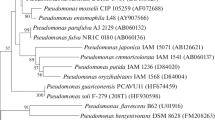Abstract
The biochemical mechanism of carbon tetrachloride transformation by poplarcells was investigated using an axenic poplar cell culture.After one-day incubations of poplar cells under aerobic conditions, about 1.5% of dosedcarbon tetrachloride was transformed to carbon dioxide, about 0.001% to chloroform andabout 3% of the carbon was bound to insoluble poplar cellular materials. The productionof carbon dioxide increased under aerobic conditions while the formation of chloroformand cell binding of carbon tetrachloride-carbon was enhanced under anaerobic conditions.Both carbon dioxide production and cell binding were significantly inhibitedby a general inhibitor of cytochrome P-450 activity (carbon monoxide) and by specific P-450 2E1 inhibitors(chlorzoxazone, isoniazid, 4-methylpyrazole and 1-phenylimidazole). However, no inhibitory effects were observed when the cells were incubated in thepresence of lignin peroxidase inhibitors (NaVO3 and 3-amino-1,2,4-triazole). These resultssuggest that an enzyme similar to mammalian cytochrome P450-2E1 is involved inthe metabolism of carbon tetrachloride by poplar cells. This study demonstratesan environmental biodegradative process for carbon tetrachloridethat operates under aerobic conditions.
Similar content being viewed by others
References
Ahr HJ, King LJ, Nastainczyk W & Ullrich V (1980) The mechanism of chloroform and carbon monoxide formation from carbon tetrachloride by microsomal cytochrome P-450. Biochem. Pharmacol. 29: 2855-2861
Anari MR, Khan S & O'Brien PJ (1996) The involvement of cytochrome P450 peroxidase in the metabolic bioactivation of cumene hydroperoxide by isolated rat hepatocytes. Chem. Res. Toxicol. 9(6): 924-931
Burken JG & Schnoor JL (1997) Uptake and metabolism of atrazine by poplar trees. Environ. Sci. Technol. 31: 1399-1406
Diaz Gomez MI, Castro JA, De Ferreyra EC & D'Acosta N (1973) Irreversible binding of 14C from 14CCl4 to liver microsomal lipids and proteins from rats pretreated with compounds altering microsomal mixed-function oxygenase activity. Toxicol. Appl. Pharmacol. 25: 534-541
Estabrook RW & Werringloer J (1977) Cytochrome P-450-Its role in oxygen activation for drug metabolism. In: Jerina DM (Ed) Drug Metabolism Concepts (pp 1-25). American Chemical Society, Washington DC
Feierman DE & Cederbaum AI (1985) Increased content of cytochrome-P-450 and 4-methylpyrazole binding spectrum after 4-methylpyrazole treatment. Biochem. Biophys. Res. Commun. 126(3): 1076-1081
Harris RN & Anders MW (1981) Phosgene: A possible role in the potentiation of carbon tetrachloride hepatotoxicity by 2-propanol. Life Sci. 29: 503-507
Hashsham SA, Scholze R & Freedman DL (1995) Cobalaminenhanced anaerobic biotransfromation of carbon tetrachloride. Environ. Sci. Technol. 29: 2856-2863
Henschler D (1985) Halogenated alkenes and alkynes. In Anders MW (ed) Bioactivation of Foreign Compounds (pp 317-347). Academy Press, London.
Khindaria A, Grover TA & Aust SD (1995) Reductive dehalogenation of aliphatic halocarbons by lignin peroxidase of Phanerochaete chrysosporium. Environ. Sci. Technol. 29: 719-725.
Kubic VL & Anders MW (1980) Metabolism of carbon tetrachloride to phosgene. Life Sci. 26: 2151-2155
Kubic VL & Anders MW (1981) Mechanism of the microsomal reduction of carbon tetrachloride and halothane. Chem. Biol. Interactions 34: 201-207
Lindros KO, Cai Y & Penttila KE (1990) Role of ethanol-inducible cytochrome P-450 11E1 in carbon tetrachloride-induced damage to centrilobular hepatocytes from ethanol-treated rats. Hepatology 12: 1092-1097
Mackova M, Macek T, Kucerova P, Burkhard J, Pazlarova J & Demnerova K (1997) Degradation of polychlorinated biphenyls by hairy root culture of Solanum nigrum. Biotechnology Letters 19: 787-790
Mico BA, Branchflower RV & Pohl LR (1983) Formation of electrophilic chlorine from carbon tetrachloride-involvement of cytochrome P-450. Biochem. Pharmacol. 32: 2357-2359
Moldeus P, Hogberg J & Orrenius S (1978) Isolation and use of liver cells. Methods Enzymol. 52: 64-86.
Newman LA, Strand SE, Choe N, Duffy J, Ekuan G, Ruszaj M, Shurtleff BB, Wilmoth J, Heilman P & Gordon M(1997) Uptake and biotransformation of trichloroethylene by hybird poplars. Environ. Sci. Technol. 31: 1062-1067
Newman LA, Wang X, Muiznieks IA, Ekuan G, Ruszaj M, Cortellucci R, Domroes D, Karscig G, Newman T, Crampton RS, Hashmonay RA, Yost MG, Heilman PE, Duffy J, Gordon MP & Strand SE (1999) Remediation of trichloroethylene in an artificial aquifer with trees: A controlled field study. Environ. Sci. Technol. 33: 2257-2265
Poyer JL, McCay PB, Lai EK, Janzen EG & Davis ER (1980) Confirmation of assignment of the trichloromethyl radical spin adduct detected by spin trapping during 13C-carbon tetrachloride metabolism in vitro and in vivo. Biochem. Biophys. Res. Commun. 94: 1154-1160
Ralph JP & Catcheside DEA (1999) Transformation of macromolecules from a brown coal by lignin peroxidase. Appl. Microbial. Biotechnol. 52(1): 70-77
Raucy JL, Kraner JC & Lasker JM (1993) Bioactivation of halogenated hydrocarbons by cytochrome P-450 2E1. Crit. Rev. Toxic. 23: 1-20
Schuler MA (1996) Plant cytochrome P450 monooxygenases. Crit. Rev. Plant Sci. 15: 235-284
Semprini L (1995) In situ bioremediation of chlorinated solvents. Environ. Health Perspect. 103: 101-105
Shah MM, Grover TA, & Aust SD (1993) Reduction of CCl4 to the trichloromethyl radical by lignin peroxidase H2 from Phanerochaete chrysosporium. Biochem. Biophys. Res. Commun. 191: 887-892
Shah H, Hartman SP & Weinhouse S (1979) Formation of carbonyl chloride in carbon tetrachloride metabolism by rat liver in vitro. Cancer Res. 39: 3942-3947
Sipes IG, Krishna G & Gillette JR (1977) Bioactivation of carbon tetrachloride, chloroform and bromotrichloromethane: Role of cytochrome P-450. Life Sci. 20: 1541-1548
Thompson PL, Ramer LA & Schnoor JL (1998) Uptake and transformation of TNT by hybrid poplar trees. Environ. Sci. Technol. 32: 975-980
Trudell JR, Bosterling B & Trevor AJ (1982) Reductive metabolism of carbon tetrachloride by human cytochromes P-450 reconstituted in phospholipid vesicles: Mass spectral identification of trichloromethyl radical bound to dioleoyl phosphatidylcholine. Proc. Natl. Acad. Sci. 79: 2678-2682
Tuisel H, Grover TA, Bumpus JA & Aust SD (1992) Inhibition of veratryl alcohol oxidase activity of lignin peroxidase H2 by 3-amino-1,2,4-triaxole. Arch. Biochem. Biophys. 293(2): 287-291
Wang X, Newman LA, Gordon MP & Strand SE (1999) Biodegradation of carbon tetrachloride by poplar trees: Results from cell culture and field experiments. In: Lesson A and Alleman BC (Eds) Phytoremediation and Innovative Strategies for Specialized Remedial Applications (pp 133-138)
Author information
Authors and Affiliations
Rights and permissions
About this article
Cite this article
Wang, X., Gordon, M.P. & Strand, S.E. Mechanism of aerobic transformation of carbon tetrachloride by poplar cells. Biodegradation 13, 297–305 (2002). https://doi.org/10.1023/A:1022397121365
Issue Date:
DOI: https://doi.org/10.1023/A:1022397121365




